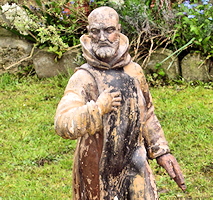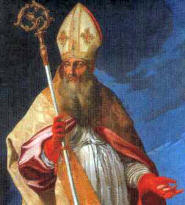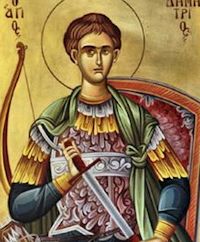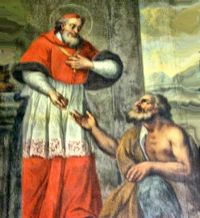Easter: April 9th
Wednesday of the Third Week of Easter
Other Commemorations: St. Gaucherius, Hermit (RM); St. Liborius, Bishop (RM); St. Demetrius of Sermium, Martyr (RM)
» Enjoy our Liturgical Seasons series of e-books!
The Paschal season is a period of Christian joy. The Church makes us repeat again and again that word which connotes a transcendent joy — "Alleluia." She bids creation to rejoice before the Lord and honor Him with psalms. She calls upon us all to praise God because of His wondrous works. This Paschal joy which now permeates our whole life, is inseparable from freedom from sin and participation in the divine life. Like a seed it is destined to grow and blossom into the Beatific Vision of God in heaven. — Cathedral Daily Missal
Alleluia
Perfect joy is deep. It is not like earthly delight which intoxicates the senses and scarcely reaches the soul, nor like that spiritual exultation which merely agitates its surface; no, joy follows from love and perfect love finds God in the depths of the spirit.
Perfect happiness is the joy of Jesus, that joy of which He spoke to His disciples at the Last Supper: "These things I have spoken to you that My joy may be in you, and that your joy may be made full." He had spoken to them of love and of suffering; He had discovered to them the mysteries of union with Him in order that His own deep joy might fill the hearts of His disciples.
The joy of the world is the pleasure of the senses; imperfect spiritual joy is the elation of the soul; perfect joy is the very joy of Jesus, the bliss of heaven that Jesus came to diffuse upon the earth and that fills the heart of His own. Perfect love brings with it the joy of Jesus because it transforms into Him; for one who loves with that most pure love is mystically Jesus and consequently he has in his heart both the sorrows and the profound joy of Jesus.
On that same blessed night, Jesus promised us the fullness of that joy and asked His Father to give it to us: "Ask and you shall receive, that your joy may be full." "But now I am coming to thee, and these things I speak in the world, in order that they may have my joy made full in themselves."'
Without doubt the complete plenitude of that joy is in heaven where all desires will find their rest, love will find complete possession, and the soul will enjoy fully the Infinite Good; but heaven is begun on earth for holy souls and during their exile these receive a certain fullness of the joy of Jesus.
The Church, most faithful spouse of Jesus and, in a certain sense, Jesus Himself, bears within her innermost heart perfect happiness, the joy of Jesus, and in spite of her constant martyrdoms, and through the strength itself of these martyrdoms, she feels the outburst of that joy which springs forth when the liturgical cycle commemorates and renews the glorious triumph of Jesus, and from her inspired lips and from her most tender heart arises the mysterious canticle of perfect joy: Alleluia!
Excerpted from Liturgical Preludes by Luis M. Martinez
St. Gaucherius
 Born in Meulan-sur-Seine to the northwest of Paris, he received a classical education and became a priest. However he felt a deep longing for solitude and a life more radically centered on God. He thereupon devoted his life God as a hermit and began with his friend, Germond, to reside in the area of Limoges. Alone and forgotten by the world, Gaucherius and Germond grew in holiness. Their example attracted others who built hermitages near to theirs. Finally Gaucherius decided to build a monastery at Aureil and to establish two communities, one for men, the other for women, both under the rule of St. Augustine. The passage of an eremitical settlement into the canonical life was one of the principal ways through which the canons regular grew in the 11th and 12th Century. The community of Aureil is typical of these kinds of Ordo Novus canons regular. Thereafter he lived with his companions, being for all a model of sanctity. His companions and disciples include St. Lambert of Angouleme and St. Faucherus as well as the founder of Grandmont monastery, St. Stephen Muret. He died 80 years old in 1140 and was canonized in 1194.
Born in Meulan-sur-Seine to the northwest of Paris, he received a classical education and became a priest. However he felt a deep longing for solitude and a life more radically centered on God. He thereupon devoted his life God as a hermit and began with his friend, Germond, to reside in the area of Limoges. Alone and forgotten by the world, Gaucherius and Germond grew in holiness. Their example attracted others who built hermitages near to theirs. Finally Gaucherius decided to build a monastery at Aureil and to establish two communities, one for men, the other for women, both under the rule of St. Augustine. The passage of an eremitical settlement into the canonical life was one of the principal ways through which the canons regular grew in the 11th and 12th Century. The community of Aureil is typical of these kinds of Ordo Novus canons regular. Thereafter he lived with his companions, being for all a model of sanctity. His companions and disciples include St. Lambert of Angouleme and St. Faucherus as well as the founder of Grandmont monastery, St. Stephen Muret. He died 80 years old in 1140 and was canonized in 1194.
—Excerpted from the Canons Regular of St. Augustine
Patronage: wood cutters
Highlights and Things to Do:
- Read more about St. Gaucherius:
St. Liborius
 St. Liborius was bishop of Le Mans (348-397), where he labored with signal success. He is said to have healed sufferers from "gravel and allied complaints," and for this reason his feast was introduced by Pope Clement XI, himself a victim who was cured through the saint's intercession. The earliest historical reference dates to the ninth century when his remains were transferred to Paderborn, Westphalia, to aid in the conversion of the Saxons; they are still there at present.
St. Liborius was bishop of Le Mans (348-397), where he labored with signal success. He is said to have healed sufferers from "gravel and allied complaints," and for this reason his feast was introduced by Pope Clement XI, himself a victim who was cured through the saint's intercession. The earliest historical reference dates to the ninth century when his remains were transferred to Paderborn, Westphalia, to aid in the conversion of the Saxons; they are still there at present.
—The Church's Year of Grace, Pius Parsch
Patronage: abdominal pains; against calculi; against colic; against fever; against gall stones; against gravel; against kidney disease; against kidney stones; Le Mans, France; Archdiocese and city of Paderborn Germany; Cathedral of Paderborn
Symbols and Representation: Book and several small stones; peacock's feather; bishop carrying small stones on a book; bishop with a peacock; peacock (legend is that when his relics were taken to Paderborn, the procession was led by a peacock); pebbles
Highlights and Things to Do:
- Read more about St. Liborius:
- There is a week-long annual festival, Libori, in Paderborn, Germany, that begins on the Saturday after his July 23rd feast day.
- St. Liborius' relics are located in the Paderborn Cathedral. According to CatholicSaints.info, the translation of his relics from Le Mans to Paderborn, Germany led to a sister-city relation that has lasted for over 1,000 years.Tthere is also a legend that when his relics were taken to Paderborn, the procession was led by a peacock.
St. Demetrius
 Saint Demetrius was born to a wealthy, noble family and raised Christian. He was a soldier and a Deacon. He was raised to the rank of Duke of Thessaly by the Emperor Maximian. But when he was found to be a Christian he was arrested and imprisoned in a bath-house. He was run through with spears c.306 at Sirmium (in modern Serbia).
Saint Demetrius was born to a wealthy, noble family and raised Christian. He was a soldier and a Deacon. He was raised to the rank of Duke of Thessaly by the Emperor Maximian. But when he was found to be a Christian he was arrested and imprisoned in a bath-house. He was run through with spears c.306 at Sirmium (in modern Serbia).
St. Demetrius was extremely popular in the Middle Ages and was reported to have appeared during a battle in 586, centuries after his death to help defend Thessalonica.
Over 200 churches in the Balkans are known to have been dedicated to him. His relics were said to emit holy oil.
—Excerpted from Evangelizo.org 2001-2014
Demetrius was probably a deacon who was martyred sometime before the fifth century at Sirmium (Mitrovic in former Yugoslavia). During that century two churches were built in his honor, one at Sirmium and the other at Thessalonica. It may be that the cult of the saint migrated from Sirmium when Leontius, the prefect of Illyricum, moved the seat of civil suthority to Thessalonica–he is reputed to have built both churches. Certainly Demetrius was honored as a saint at Sirmium before the church at Thessalonica was built. Sirmium, however, was destroyed by the invading Huns in 441, and it was the second church that became the principal center for the cult of the martyr and attracted very large numbers of pilgrims. The church was destroyed by fire in 1917 but has since been rebuilt; it was obviously meant to hold a great number of people.
In time Demetrius became known as "the Great Martyr," and a legend grew up about his life. According to this he had been a citizen of Thessalonica who had been arrested for preaching the gospel and executed without trial in the local baths. The church was built over the baths and incorporated part of them as a kind of crypt. At a later date relics of the saint were said to exude a miraculous oil, but the arrangements whereby the pilgrims could collect some of this seem to have been quite fraudulent.
The earliest written account we have dates from the ninth century and says that the order for his execution came from the emperor Maximian himself. Later accounts make out that he was a proconsul (this is how the Roman Martyrology described him) or a warrior-saint similar to St. George and second only to him in popularity. He as one of the saints adopted by the Crusaders as their patrons in battle. None of these later accounts can be trusted, though we can be sure of the existence of a martyr of that name. His feastday is kept with great solemnity throughout the Eastern Church on October 26, and he is named in the preparation of the Byzantine liturgy. The popular Slav name, Dmitry, comes from him. His cult was popular also in Ravenna in Italy, where the earliest chapel was dedicated in his honor.
The original basilica, destroyed in 1917, had important mosaics from the sixth to the ninth century; in these Demetrius was portrayed as a deacon. More often he was depicted as a soldier.
—Excerpted from Butler's Lives of the Saints, Volume 10
Patronage: Crusaders; soldiers; Belgrade, Serbia; Salonica, Greece; Thessaloniki, Greece
Highlights and Things to Do:
- Learn more about St. Demetrius:






